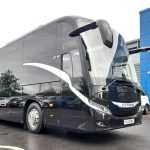Optare’s MetroDecker has now been with us, in Euro 6 diesel form, for nearly four years. When launched at Covent Garden, London, in May 2014 it was Optare’s first venture into the integral double-decker market. With an unladen weight around 10 tonnes it was substantially lighter than its competitors.

Since then, its demonstrators have ‘done the rounds’ and been widely liked, but the crucial large order – which would unlock the investment to productionise the build process – has proved elusive due to, shall we say, ‘market conditions’.
Now the game has moved on and it’s in a market of two, as one of only two full-electric production-ready conventional double-deckers.
This, hopefully, will unlock the large order that Optare has been pitching for, which in turn will also enable production of the Euro 6 version.
Go-Ahead London is currently trialling the bus, and Optare kindly made it available for an exclusive routeone Test Drive.
Build
Much of the vehicle is very familiar, and for good reason. This is the former diesel demonstrator from the May 2014 launch. Now re-powered using Magtec’s established electric drive with a single traction motor, powered by lithium iron magnesium phosphate batteries, it is repainted in London’s ‘leaf’ livery, for its new role.
Despite the conversion and the extra equipment required for London use (roller blinds, iBus, communications systems and so on), it tips the scales at only 11,160kg – substantially less than some single-decker EV competitors. This also means it has not had to apply for a gross weight derogation. So far, so good.
With almost 12,000 miles on the clock, now’s the time that wear would start to show. Demonstrators can lead a hard life and close inspection reveals that apart from the re-power, the structure and interior have not been altered, yet there’s no signs of deterioration.
All electric vehicles have a trade-off on range. You can fill a vehicle full of batteries to deliver a massive range, but the trade off is capital cost and passenger capacity.
The general view is that a 200-mile daily range is the UK industry target for a bus. Current models in service from all manufacturers tend to use a top-up in the day (such as on park-and-ride), or spend most of their life on peak duties.
Optare is also aiming for the 200 miles; the MetroDecker EV is regularly doing 80 miles a day, for which it needs a six-hour charge. Its forecast range is 105-145 miles on a single charge. Currently the electric bus does two duties a day, compared with four for a diesel, while more experience of its capability is gained.
This is a 200kW/h bus, using three battery modules filling the engine bay. The drive system is cooled by electric fans in the former engine bay. Indeed, open the bonnet and there’s nothing to see. A 40kW on-board charger connects to a standard commercial three-phase supply.
It’s being used on route 36, from New Cross Garage, which wanders its way north west via Vauxhall and Paddington to Queen’s Park station. The 10-mile route takes 1.5 hours each way.
Passenger access
We’ve looked at the bus in its diesel-powered version twice (in 2014 this bus and 2016 – the 11.14m provincial version) and our appraisal has not altered – and neither has the bus. It has a light, airy saloon and is passenger friendly. Over 6ft of headroom is available throughout the lower deck, and the platform area is well lit.

In its two-door London Spec the total passenger capacity of 99 is achieved with 63 seats (22 downstairs and 41 upstairs).
The staircase is easily navigated, helped by well-located handrails. The area around the upper deck ‘pulpit’ also has plenty of handholds. The stanchions are drawn in at the top to create more gangway space. Bell pushes are wireless, giving plenty of operator choice on positioning.
Passenger comfort
The seats are comfortable and have handholds in the backs, but the crucial item for all buses – especially two-door ones – is the heating system. Be clear; this is a full electric bus (no diesel-fired heater).

An Eberspächer fully automatic integrated heating and air conditioning system with thermostatically-controlled blown heating, venting and chilling (upper deck) is fitted.
Our drive was on a day before the snows, but with a biting east wind. Nevertheless, within yards of leaving the depot on the bus that had been standing outside, the interior temperature was swiftly raised. Within a few minutes the saloon was comfortable and remained so. It also has the advantage of reducing condensation- a citybus bugbear.
The downside is that electric heating systems use power; but already Optare is working on an updated system.
Contrary to our expectations, the roads in South London we used had recently been resurfaced, providing a beautiful ride. Where ‘normal’ potholed roads were encountered, the bus rode very well, with no major rattles despite its four years on the road. Only a slight rattle from the assault screen over potholes was the only observation.
Normal London bus passengers will also be pleasantly surprised by the good seat padding.
Driver comfort
The cab is class-leading and not at all like cramped cabs that double-deckers can sometimes be. The assault screen could benefit from some holes as it’s hard to hear passengers, but otherwise the environment is very good. It is largely unchanged from the diesel version, retaining a high-backed Chapman driver’s seat, while the steering wheel is infinitely adjustable for rake and reach.

The handbrake falls exactly where you’d want it next to your right hand, while drive is selected by push buttons. Optare’s EcoDrive dash is fitted and, apart from a display showing battery levels rather than fuel, it is standard as is the rest of the cab. The binnacle does not obstruct the windscreen; CCTV screens are above the windscreen.
Cab heating is via demister vents, which worked well, and fresh air outlets are fitted.
The mirrors are very effective, making it easy to keep a watchful eye on those pedal cyclists and motorcyclists whose interpretation of the Highway Code is, shall we say, unique.
Indeed all-round vision is good, although the arrangement of the offside mirror/pillar means that care with vehicle positioning must be taken, especially at roundabouts, to avoid creating a blind spot.
Performance
To experience the full potential of the decker, rather than the slow stop-start route 36, New Cross Garage Mentor Lorriat Martin devised a varied route. Once we’d escaped the Borough-wide 20mph zone in Lewisham, our route took in normal roads, some with tight corners, high street environments plus a section of dual carriageway.

We’ve now tested a few ‘new fuel’ buses and when the noise of a diesel engine is removed, other sounds that it masks are exposed. That’s not an undue challenge for the Optare though. There’s a very slight, barely noticeable, hum from the compressor (under the stairs), and it’s without the high-pitched general ‘hum’ when standing.
Underway, the traction motor is audible, but not unduly so, and it all makes for a quiet, smooth bus.
Recent TV adverts for the all-electric new Nissan Leaf car have made much of its e-Pedal that allows the driver to start, accelerate, decelerate and stop using only the accelerator pedal.
The Optare is very similar to this, and the footbrake is only needed for emergency braking or when coming to the final part of a halt going downhill.
In normal driving we didn’t need to touch the brakes, apart from when on a hill. A change to the software after our visit was planned to introduce a hill-hold function. Similarly there is no ‘creep’ when stationary; to make the bus move from rest on the level, the accelerator must be pressed.
This sounds complex, but in truth, it’s a lovely and easy vehicle to drive. The adaption to the driving style takes only a few minutes to master.
And, unlike some other electric buses we’ve tried, gentle pressure on the pedal produces a gentle start. With electric motors delivering high torque from the get-go, rapid take-off that throws passengers from their feet is not a uncommon trait; but not so here.
Despite this, press the pedal harder and the bus quickly picks up its skirts. On a section of 40mph dual carriageway, the bus rapidly attained and easily held this speed. Although it has a maximum of 85km/h (52mph), for London this has been electronically limited to 40mph.
Additionally, the pedal is weighted to discourage heavy-footed driving.
Under deceleration, again the software has this nicely balanced and it’s easy to make smooth stops. Early electrics had unduly powerful retardation, but with the Optare we are in Goldilocks territory i.e. it’s ‘just right’.
Similarly, the steering is positive and even on a day with strong breezes, on exposed sections of the dual carriageway, the bus held its line without the need for correction.
Verdict
There remains a substantial premium for electric buses, meaning that without government or other support – such as through the TfL tendered system – they are not yet a commercial proposition.

Go-Ahead London runs Europe’s largest electric bus operation from its Waterloo garage, proving that not only is it technically viable, but is also practical for city routes.
Therefore, it is not surprising that Go-Ahead is keen to be the first to test Optare’s EV ‘decker in public service. We are grateful to New Cross GM Graham Johnson and Executive Support Officer Assistant Eugene Clarke for their assistance in making our exclusive test drive possible.
Overall, this Optare is a good bus. The packaging means that from a saloon point of view, there are no compromises; it has the same internal space and passenger capacity as a standard diesel bus. In terms of ambience and access it’s up there with the best.
It is easy and relaxing to drive, allowing all concentration to be kept on the road ahead and users around you. And, importantly, it’s also easy to give your passengers a smooth ride.
During our 12-mile test, the battery level went from 96% to 86%. As it was a dull day, with all the lights and electric heating on that’s not surprising.
It has a distinct advantage with its low weight and that, in all other respects, it is conventional.
Optare already has a track record in the all-electric single deck market, with vehicles in the tough London market, as well as elsewhere.
Already Optare is working on the next version of this double-decker, which will move the range on a further notch. If it can secure orders from the current all-electric route TfL tenders, this will provide a substantial springboard.
























